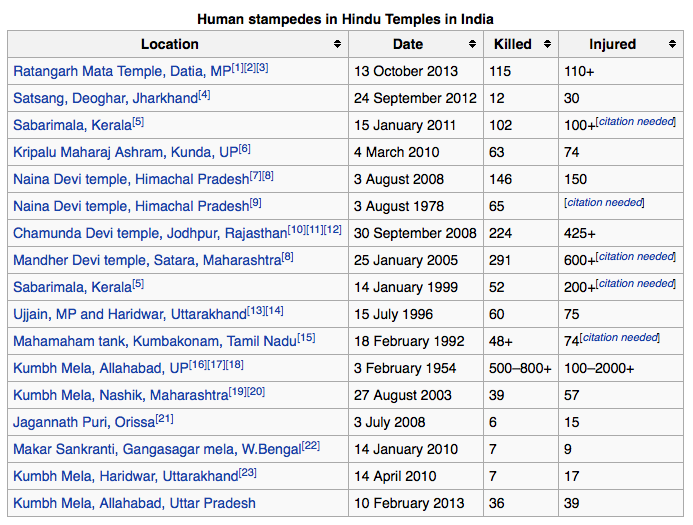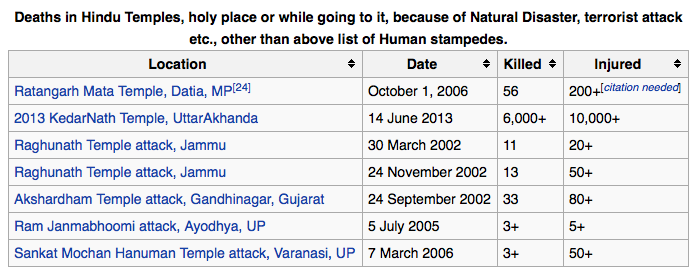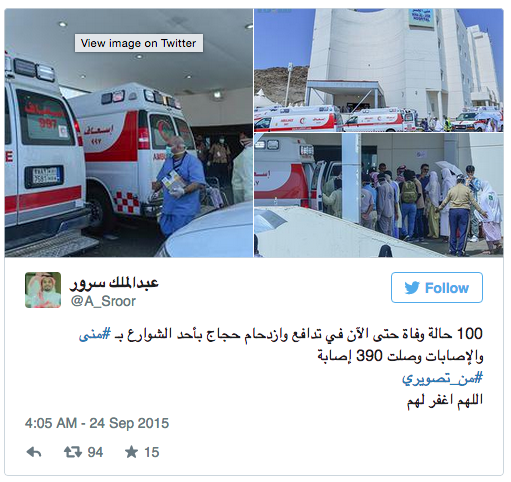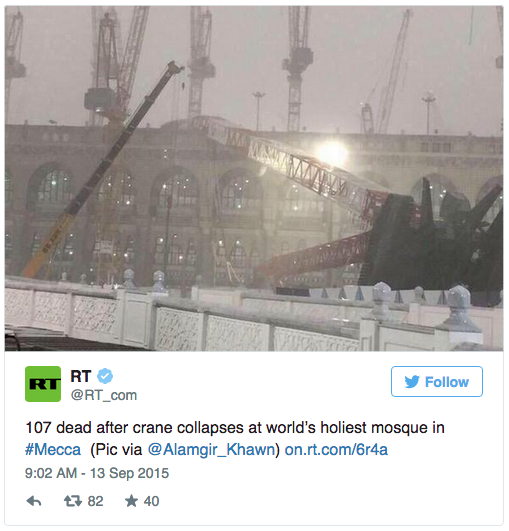Are the deadly pilgrimage stampedes being incited by black op provocateurs?
TMR Editor’s Note:
There has been a spate of pilgrimage deaths due to stampedes over the past few years which can no longer be ignored. The vast majority of them occur on Muslim holy days or at the most revered Islamic shrines in the Middle East. Many others have taken place at Hindu Temples or during Hindu festivals. The following list of Hindu stampedes illustrates just how common these events have become.
The list below is even more troubling because it indicates that there is a definite pattern of targeting devotees and pilgrims while congregating at their temples. When considered with this compilation of deliberate attacks, one can only wonder whether the above stampedes may have been triggered by agent provocateurs. There is certainly incentive for furtive groups to take advantage of unsuspecting and weary pilgrims who have traveled great distances.
~~~~~~~~~~~~~~~~~~~~~~~~~~~~~~~~~~~~~~~~~~~~~~~~~~~~~~~~~~~~~~~~~~~~
Mecca stampede: 717 people killed, 863 injured in Hajj crush (PHOTOS, VIDEO)
RT.com
220 ambulances and 4,000 rescue workers were deployed in the field for emergency treatment of the victims of the crush.
The crush happened in Mecca’s neighborhood of Mina, which traditionally provides temporary accommodation for hundreds of thousands of pilgrims. The ritual of the ‘Stoning of the Devil’ is performed in a valley surrounding the neighborhood on the night before last day of the Hajj.
The stampede happened in a street separating two pilgrim camps, Al Jazeera reported from the scene.
“The street is named Street 204. This stampede did not happen during the Stoning of the Devil ritual, which was happening today,” correspondent Basma Atassi said.
Street 204 is one of the two main arteries in Mina leading through the camp at Mina to Jamarat Bridge, where the Stoning of the Devil ritual is performed.
The incident happened near an exit from a monorail train station near the tent camps. The camp sector houses pilgrims from Gulf nations, who apparently are the majority among the victims.
Muslims worldwide are celebrating on Thursday the holy day of Eid al-Adha. An estimated 2 million pilgrims traveled to Mecca for the celebration.
Just two weeks ago over a hundred people were killed in Mecca when a construction crane fell on the crowded Grand Mosque. The worshipers had gathered in the city ahead of this year’s Hajj.
Mina has seen a number of fatal stampedes over the years. In 1990 over 1,400 pilgrims died in a stampede inside a pedestrian tunnel leading out of Mecca towards Mina, one of the most catastrophic of such incidents.
A number of stampedes happened on the Jamarat Bridge. The death of almost 350 pilgrims in 2006 finally prompted Saudi Arabia to conduct reconstruction of the bridge to avoid such tragedies.
The Al-Ma’aisim tunnel stampede is the worst single such incident, although the Thursday tragedy in Mina appears to be the second-deadliest during the Hajj. Other countries have suffered high death tolls over crowd control failures as well.
About 1,000 Shiite believers were killed in Baghdad in 2005 during a stampede at the Al-Aaimmah Bridge over the River Tigris. The crowd of pilgrims was marching toward the Al Kadhimiya Mosque when panic spread over rumors of an imminent suicide bombing attack.
India is infamous for human stampedes during religious festivities. One of the deadliest such incidents happened in 1994 during Kumbh Mela pilgrimage, which claimed some 800 lives. The high number of fatalities was caused by a combination of the River Ganges changing course, reducing the available space for pilgrims, and the heavy presence of politicians using the gathering to campaign among their electors.
In Europe the worst-ever crush, with a recorded death toll of around 1,300, was in Khodynka Field near Moscow in 1896, when the Russian Empire celebrated the crowning of Tsar Nicholas II. Mementoes to the subjects were offered by the royal family, but the authorities utterly failed in their distribution. When rumors spread among the half-million-strong crowd that some of the gifts had been embezzled and a shortage had occurred, the people rushed to the tents to grab whatever was left.
An incident painfully similar to the Khodynka tragedy in both its cause and the resulting public outrage happened in Sunderland, England, in 1883. After a children’s variety show in Victoria Hall, an estimated 1,100 children rushed out to receive promised treats, creating a bottleneck at the exit doors. The crush resulted in the deaths of 183 children.






